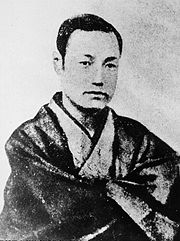- Morita Kanya XII
-
Morita Kanya XII Born 9 November 1846 Died 21 August 1897 (aged 50) Nationality Japan Information Genre Kabuki Morita Kanya XII (十二代目守田勘弥) (9 November 1846 - 21 August 1897) was the leading Japanese theatre manager of the first half of the Meiji period, between 1868 and 1912. He built the first modern theater, the Shintomi-za (新富座), which incorporated Western features such as gaslights and chairs. The theater opened in June 1878, and was located at a foreign settlement in Tsukiji, Tokyo. He was also a crucial factor in attracting the new audience, the aristocracy, into the kabuki theaters (Kikan).
Contents
Early life
It is said that Morita Kanya XII, as a young boy of 12 years, ran to the port of Yokohama in an attempt to leave Japan and immigrate into the Western world for the sake of fulfilling his goal: becoming a millionaire. Although the shogunal police stopped him that time, his spirit and interest for the West remained an integral part of his personality. During the time of government takeover (1868), the 22 year old Morita Kanya XII became so obsessed with the Western world that he would eat sashimi (a traditional Japanese dish) with salt and pepper as opposed to soy sauce and wasabi (Yuichiro).
The Kabuki reforms
The Kabuki theater was greatly affected during the reforms of the Meiji period. The main concern of the government was to transform the art of Kabuki into something similar to that of the western form. This placed theater from a common into a high social role, in which aristocrats and nobles would come and view the performances. Kabuki was to represent a civilized Japan (mostly for the sake of impressing westerners). In 1872, Kabuki leaders, including Morita Kanya XII were asked to participate in a discussion at the Tokyo city hall. There, the changes were addressed and Morita Kanya XII saw this as an opportunity to become a wealthy businessman with the hope to become the director of the future National Theatre of Japan. When he built his Shintomi-za he implemented the desired reforms, which later were referred to as “engeki kairyo.” (Tschudin)
Career
Morita Kanya was the owner of one of the three theatres licensed under the Tokugawa shogun regime: the Morita-za. Following the government takeover in 1868, Morita Kanya built the Morita-za in 1872, which marked a transformation of the Japanese Kabuki theater structure. In 1875, he had financial difficulties and reorganized the Morita-za into a company, which changed the theater’s name to Shintomi-za. A year later in 1876, the theater burned down, but Morita Kanya immediately rebuilt after its destruction. In 1878 it was completed and named Shintomi-za. (Yuichiro) The Shintomi-za was furnished with Western chairs designed for Western visitors and gas lighting for the stage. The climax of Morita Kanya XII’s career was when foreign aristocrats such as Crown Prince Heinrich of Germany and U.S. President Ulysses Grant came to the Shintomi-za to view his plays. (Brandon) All of these changes transformed Shintomi-za into Japan’s “national theatre”, although it was not referred to as such.[1]
Morita Kanya XII’s changes in the world of Kabuki theater
Elimination of thrust stage
During the heyday of Kabuki in the Edo period (1603–1868), the relationship between actor and audience was supposed to be strong and intimate. This meant that it was common for actors to interact with its audience. For instance, in the midst of the performance, the actors would come onto the “thrust stage” (a stage that extends into the audience) and interact with them. Morita Kanya XII with his attempt to transform kKabuki into a more respectable art form eliminated the thrust stage, thereby adhering to a western convention. This ended the relationship between actor and audience. (Samuel L. Leiter, ed., A Kabuki Reader (Armonk, NY: M.E. Sharpe, 2002))
Reform of Kabuki plays
In 1878, Morita Kanya XII, following the government’s demand for historical accuracy, produced the play “Okige no Kumo Harau Asagochi” which was based on a real recent uprising. He also integrated elements of “good” morale into the dialogues of his actors, with the goal to civilize the commoners (Yuichiro). He also westernized some plays to appeal to western visitors. For instance, he wrote two Kabuki plays set in Europe in 1879. At another instance he would hire a play writer to create a play based on the General Grant’s victories in the American Civil War. (Brandon)
Changes in architecture and furniture
The use of Western chairs for the audience, now standard in all Japanese theatres, was introduced in Kanya's Shintomi-za. The size of the stage, which remained the same for over a century, was also enlarged when Morita Kanya XII built the Shintomi-za. (Yuichiro)
Later life
In 1894, Morita Kanya XII was forced to give up his theater management duty [2]. He had a major financial crisis in which he lost 20,000 yen in the production of the play Hyoryu Kidan Seiyo-geki, which turned out to be very unsuccessful due to the poor acting of Western performers (Yuichiro). In 1909, the Shintonomi-za was bought by Shochiku.[2]
Notes
- ^ "Masterpieces of Kabuki". James R. Brandon and Samuel L. Leiter. University of Hawaii Press. 2004. http://www.uhpress.hawaii.edu/books/brandon-master-intro.pdf.
- ^ a b "Morita-za". The Samurai Archives. http://wiki.samurai-archives.com/index.php?title=Morita-za.
Sources
- Kikan, Kimura, Morita Kanya (Tokyo: Shintaishū-sha, 1943).
- Brandon, James, “Kabuki and Shakespeare, Balancing Yin and Yang,”
- Tschudin, Jean-Jacques, “Danjuro's katsureki-geki (realistic theatre) and the Meiji 'theatre reform' movement',” Japan Forum 11 no. 1 (1991).
- Yuichiro, Takahashi, “Kabuki Goes Official: The 1878 Opening of the Shintomi-za,” The Drama Review 39 no. 10 (1995).jp:守田勘彌 (12代目)
Categories:- Theatre in Japan
- 1846 births
- 1897 deaths
Wikimedia Foundation. 2010.

